David Crosby | ||
| Allmusic Biography : The singular odyssey of David Crosby remains one of the more remarkable tales in the annals of music history. As a founding member of the pioneering American groups the Byrds and Crosby, Stills & Nash, he helped create and popularize the highly influential folk-rock sound, forging the richly harmonic, radiantly acoustic approach that defined the West Coast music scene for years to follow; he also sold millions of records and enjoyed a cultural impact equaled by few of his contemporaries. Yet despite his often overwhelming success, Crosby is recognized far less for his artistic achievements than for his larger-than-life off-stage exploits, specifically a long and fantastically excessive battle with drug abuse that seemingly kept him teetering on the brink of death for over a decade; that he not only survived but remained as colorful and newsworthy a character as before is a testament to his continued creativity and unpredictability. Crosby was born in Los Angeles on August 14, 1941; the son of Academy Award-winning cinematographer Floyd Crosby, he dropped out of drama school to pursue a career in music, touring the folk club circuit and recording as a member of the Les Baxter Balladeers. Under the auspices of producer Jim Dickson, Crosby cut his first solo session in late 1963; early the following year he formed the Jet Set with Jim McGuinn and Gene Clark, and with the additions of bassist Chris Hillman and drummer Michael Clarke, the group was rechristened the Byrds. Although McGuinn chiefly pioneered the Byrds trademark 12-string guitar sound, Crosby was the architect of their shimmering harmonies; his interest in jazz and Indian music also influenced their subsequent excursions into psychedelia. However, creative differences plagued the group throughout its career, and in 1967 Crosby -- reportedly rankled by his bandmates refusal to release his ménage à trois opus "Triad" -- left the Byrds in the wake of their appearance at the Monterey Pop Festival. After producing Joni Mitchells 1968 debut LP, Crosby cut a handful of solo recordings and began jamming with ex-Buffalo Springfield singer/guitarist Stephen Stills. In time, the duo was joined by ex-Hollies member Graham Nash; with its exquisitely beautiful three-part harmonies, strong individual songwriting contributions, and graceful folk-rock sound, Crosby, Stills & Nashs 1969 debut LP proved a pop landmark, launching all three members to greater fame than theyd experienced in any of their previous projects. The addition of Stills former Buffalo Springfield bandmate Neil Young expanded the group to a four-piece, and in August of 1969 Crosby, Stills, Nash & Young (CSNY) made just their second live appearance to date at the Woodstock Festival; 1970s Déjà Vu arrived in stores with advance orders numbering over two million, and through the thought-provoking social and political messages of songs like "Woodstock" and "Ohio," they emerged as generational torch bearers of enormous musical and cultural influence. Following a sold-out CSNY tour, the group went on hiatus, and Crosby resumed work on his long-delayed solo debut, releasing If I Could Only Remember My Name in 1971; the following year, he and Nash issued the first of several duo efforts, and he also took part in a short-lived Byrds reunion. Despite continued creative differences, CSNY re-formed for a 1974 tour; Crosby and Nash issued Wind on the Water a year later, and in 1977 Stills returned to the fold for the multi-platinum CSN. However, as Crosbys longstanding drug problem continued to worsen, he eventually fell out with both Stills and Nash, and a planned second solo album, Might as Well Have a Good Time, was rejected by Capitol in 1980. A series of arrests for cocaine possession and illegal weapons charges hampered him throughout the years to follow, even as he reunited with Stills and Nash in 1982 for the Top Ten hit Daylight Again. After completing the follow-up, 1983s Allies, the trio did not record together for another seven years. In late 1985 Crosby was sentenced to prison after fleeing the drug rehabilitation clinic hed entered in lieu of serving out a previous jail term; upon his release the following August, hed finally conquered his demons, later chronicling the ugly details of his addiction in the fine autobiography Long Time Gone. In 1988 -- a full 18 years after the release of Déjà Vu -- Crosby reunited with Stills, Nash, and also Young for American Dream; his second solo effort, Oh Yes I Can, finally appeared the following year as well. After the 1990 release of CSNs Live It Up, Crosby continued to suffer personal misfortunes -- first he was severely injured in a motorcycle accident, and then in 1994 he lost his L.A. home as a result of massive earthquake damage. Months later, he returned to the headlines when it was announced he was diagnosed with hepatitis C and dying of liver failure, undergoing a successful organ transplant in 1995. During the recovery period that followed, Crosby met James Raymond, the son hed given up for adoption over three decades earlier and a professional musician as well; the two soon began writing songs together, and with guitarist Jeff Pevar they formed CPR, releasing a series of albums and touring regularly. In early 1997, Crosby, Stills & Nash were inducted into the Rock and Roll Hall of Fame; six years earlier, Crosby had first entered the Hall of Fame as a member of the Byrds. Young returned to the fold for 1999s Looking Forward, with the resulting millennial tour -- dubbed "CSNY2K" -- heralding the foursomes first joint road venture in a quarter century. Crosby was again the subject of tabloid headlines when in early 2000 it was revealed that he fathered the children of singer Melissa Etheridge and her partner Julie Cypher; that same year, he also published a second book, Stand and Be Counted, which assembled interviews with actors and musicians to explore the intersection of celebrity and social activism. From 2001 onward, a Crosby, Stills & Nash tour became a regular and annual event, with Crosby finding safe haven and camaraderie on-stage alongside his musical compatriots of over four decades. In both 2002 and 2006, Neil Young completed the CSNY lineup for their live dates, and although the politically motivated 2006 Freedom of Speech tour was very much driven by Youngs muse, Crosbys "Déjà Vu" was a cornerstone of the set and served as the title for the both the 2008 live album and film that documented the tour. Also in 2006, Crosby, along with Nash, accompanied Pink Floyd guitarist David Gilmour on sessions for his solo album, On an Island, and the pair went on to help him promote the record on tour. The expansive, lavishly packaged three-disc retrospective Voyage was issued in 2007. Produced by Nash and archivist Joel Bernstein, the collection married two discs of classic material with a disc of unreleased recordings and set the template for both Nashs 2009 Reflections and Stills 2013 Carry On. In summer 2013, Crosby began to talk about the sessions for his fourth solo album, his first in over 20 years. Produced in conjunction with his son Raymond and featuring contributions from Wynton Marsalis and Mark Knopfler, Croz appeared in late January 2014. The singer/songwriter next collaborated with Snarky Puppys Michael League. The pair wrote some songs together, and then debated how long it would take to record an album. League wanted two weeks; Crosby wanted a month. Working at Jackson Brownes Groove Master studios, it was completed in 12 days. The first single, "Things We Do for Love," was released in July of 2016; the full-length Lighthouse followed in October. Continuing this prolific late-career run, Crosby released another full-length record the following year. Released in September 2017, Sky Trails was again produced by Raymond, and included a cover of Joni Mitchells "Amelia," from her 1976 album Hejira. He announced a coinciding fall tour of the U.S. to support the album. Crosby quickly followed Sky Trails in October 2018 with Here If You Listen, which once again featured the Michael League-anchored band that supported the singer/songwriter on Lighthouse. | ||
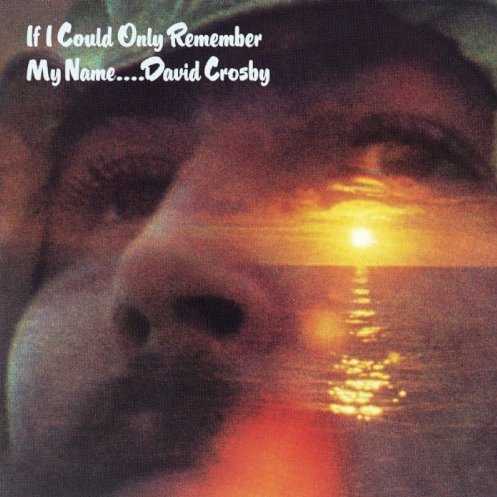 | Album: 1 of 13 Title: If I Could Only Remember My Name Released: 1971-02-22 Tracks: 9 Duration: 37:50 Scroll: Up Down Top Bottom 25% 50% 75% Spotify TrackSamples Allmusic Wikipedia AlbumCover | 1 Music Is Love (03:21) 2 Cowboy Movie (08:11) 3 Tamalpais High (at About 3) (03:32) 4 Laughing (05:25) 5 What Are Their Names (04:14) 6 Traction in the Rain (03:46) 7 Song With No Words (Tree With No Leaves) (06:00) 8 Orleans (02:01) 9 I’d Swear There Was Somebody Here (01:19) |
| If I Could Only Remember My Name : Allmusic album Review : David Crosbys debut solo album, If I Could Only Remember My Name is a one-shot wonder of dreamy but ominous California ambience. The songs range from brief snapshots of inspiration (the angelic chorale-vocal showcase on "Orleans" and the a cappella closer, "Id Swear There Was Somebody Here") to the full-blown, rambling western epic "Cowboy Movie," and there are absolutely no false notes struck or missteps taken. No one before or since has gotten as much mileage out of a wordless vocal as Crosby does on "Tamalpais High (At About 3)" and "Song With No Words (Tree With No Leaves)," and because the music is so relaxed, each song turns into its own panoramic vista. Those who dont go for trippy Aquarian sentiment, however, may be slightly put off by the obscure, cosmic storytelling of the gorgeous "Laughing" or the ambiguous (but pointed) social questioning of "What Are Their Names," but in actuality it is an incredibly focused album. Even when a song as pretty as "Traction in the Rain" shimmers with its picked guitars and autoharp, the album is coated in a distinct, persistent menace that is impossible to shake. It is a shame that Crosby would continue to descend throughout the remainder of the decade and the beginning of the next into aimless drug addiction, and that he would not issue another solo album until 18 years later. As it is, If I Could Only Remember My Name is a shambolic masterpiece, meandering but transcendentally so, full of frayed threads. Not only is it among the finest splinter albums out of the CSNY diaspora, it is one of the defining moments of hungover spirituality from the era. | ||
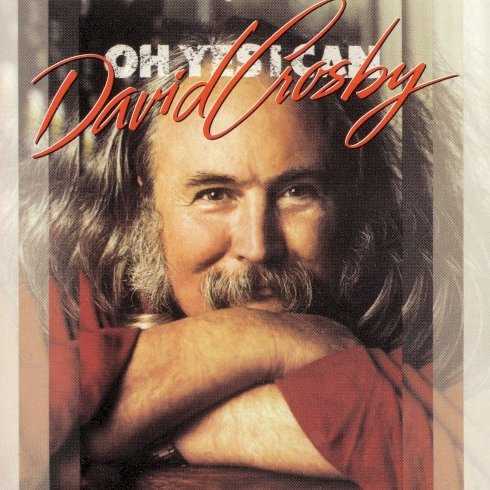 | Album: 2 of 13 Title: Oh Yes I Can Released: 1989 Tracks: 11 Duration: 42:44 Scroll: Up Down Top Bottom 25% 50% 75% Allmusic Wikipedia AlbumCover | 1 Drive My Car (03:38) 2 Melody (04:11) 3 Monkey and the Underdog (04:20) 4 In the Wide Ruin (04:54) 5 Tracks in the Dust (04:48) 6 Drop Down Mama (03:09) 7 Lady of the Harbor (03:24) 8 Distances (03:39) 9 Flying Man (03:29) 10 Oh Yes I Can (05:14) 11 My Country Tis of Thee (01:53) |
| Oh Yes I Can : Allmusic album Review : After spending nearly nine months as a guest of the Texas penal system, veteran rocker David Crosby emerged from his incarceration sober and brimming with ideas that had previously been stunted due to decades of substance abuse. In many ways Oh Yes I Can (1989) -- Crosbys second solo effort during his two-decade-plus career -- is a musical rebuttal to his equally vital debut effort, If I Could Only Remember My Name (1971). Even the albums title appears to indicate his newly achieved success and freedom from the haze that so indelibly influenced the earlier compositions. Along with a cast that rivals the all-star crew featured on his first platter, Crosby is joined by the likes of James Taylor (vocals), Jackson Browne (vocals), Bonnie Raitt (guitar), Larry Carlton (guitar), David Lindley (guitar), and Michael Hedges (guitar). While pop and rock styles have changed dramatically during the 18-year disparity separating the two LPs, perhaps not surprisingly, true sonic craftsmanship hasnt. Although Crosby is known for rebellious rockers, including "Almost Cut My Hair" and "Long Time Gone," the real growth in his songwriting and arranging occurred on intricate melodies such as the wordless, jazzy, scat vocal splendor of "Flying Man" or the stunning "Distances." In fact, the latter tune instantly recalls the minor-chord changes that he and Jerry Garcia once worked up on an informal jam titled "Kids and Dogs." The reflective and introspective "Tracks in the Dust" and title composition "Oh Yes I Can" exude a catharsis-like healing that has become a leitmotif throughout Crosbys body of work. The evidence ranges from "Guinnevere" and "Traction in the Rain" to even later pieces such as "1,000 Roads." The bluesy "Drop Down Mama" as well as the pulsating struggle of "good vs. evil" on "Monkey and the Underdog" are certainly not without considerable merit, but pale when juxtaposed beside the more emotive material. | ||
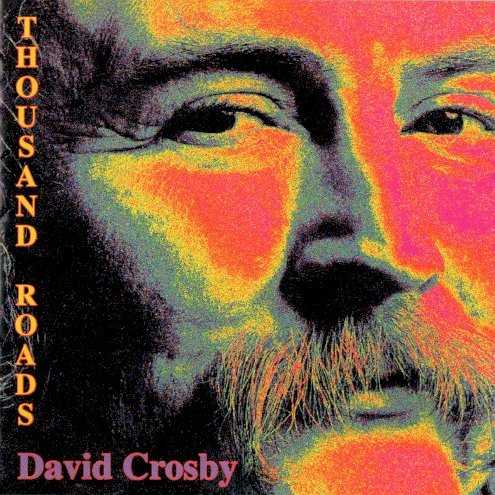 | Album: 3 of 13 Title: Thousand Roads Released: 1993 Tracks: 10 Duration: 47:25 Scroll: Up Down Top Bottom 25% 50% 75% Spotify Allmusic Wikipedia AlbumCover | 1 Hero (04:38) 2 Too Young to Die (05:47) 3 Old Soldier (04:58) 4 Through Your Hands (04:35) 5 Yvette in English (05:53) 6 Thousand Roads (04:32) 7 Columbus (04:26) 8 Helpless Heart (04:18) 9 Coverage (03:23) 10 Natalie (04:55) |
| Thousand Roads : Allmusic album Review : David Crosby, the reluctant solo artist, made his first solo album, If I Could Only Remember My Name, with an all-star guest list, then waited 18 years to make another. For his third solo album, Thousand Roads, Crosby increased the participation of his guests and attempted to redefine himself as an artist. Where previously, whoever was playing or singing on the track, the song was a Crosby composition, on Thousand Roads Crosby acted primarily as an interpretive singer, penning only one of the 10 songs and contributing to two others. He also brought in eight people to help produce the album, as if this were a Whitney Houston project on which every song was a potential single. The result certainly was a craftsman-like set of songs written by pop professionals -- Phil Collins, Jimmy Webb, Marc Cohn, John Hiatt, Paul Brady, Stephen Bishop -- and produced by the cream of pop producers -- Don Was, Glyn Johns, Phil Ramone. The failings were, first, that Crosbys individuality was lost and, second, that, as the list suggests, his choices were more calculated than inspired. The problem with David Crosby as a solo artist was not how to make him sound more conventional, it was how to make his unconventionality work. Thousand Roads solved the wrong problem, and though Crosbys collaboration with Phil Collins, "Hero," rode halfway up the singles charts (and high into the easy listening lists) largely on Collinss fame and the lyrics winking references to Crosbys jail time, the album was Crosbys least successful in the record stores. | ||
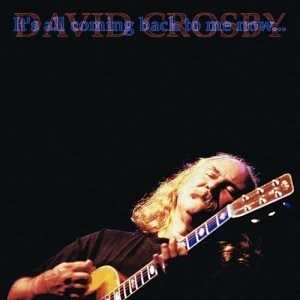 | Album: 4 of 13 Title: Its All Coming Back to Me Now... Released: 1994 Tracks: 10 Duration: 1:11:11 Scroll: Up Down Top Bottom 25% 50% 75% Spotify Allmusic Wikipedia AlbumCover | 1 In My Dreams (06:31) 2 Rusty and Blue (07:08) 3 Hero (04:57) 4 Till It Shines on You (05:38) 5 Thousand Roads (05:02) 6 Cowboy Movie (09:08) 7 Almost Cut My Hair (06:09) 8 Deja Vu (10:17) 9 Long Time Gone (05:41) 10 Wooden Ships (10:36) |
| It's All Coming Back to Me Now... : Allmusic album Review : Recorded December 7, 1993, at the Whisky-a-Go-Go in Hollywood, CA, this is a David Crosby live album and a good representation of his solo concert performances. In fact, its a little better than usual since Crosby is joined by singers Chris Robinson of the Black Crowes and his old partner Graham Nash. Crosby splits the 71-minute set just about evenly between more recent solo efforts -- including two newly written songs -- and faithful renditions of favorites from his Crosby, Stills, Nash & Young days. Inadvertently, the set list serves to confirm that the latter represents his best work, while at the same time songs like "Long Time Gone" and "Wooden Ships" have been heard so often in studio and live performances that there isnt much reason to have additional recordings of them. The albums chief virtue is in the expression of Crosbys personality, but there isnt enough of that. So, while these are often spirited performances, they dont add to our understanding of the artist the way a live album should. | ||
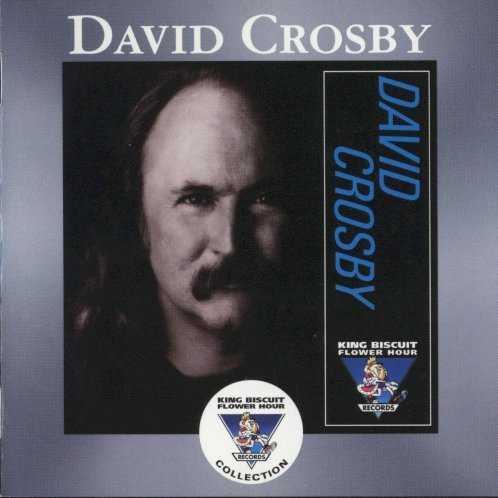 | Album: 5 of 13 Title: King Biscuit Flower Hour Released: 1996 Tracks: 14 Duration: 1:14:19 Scroll: Up Down Top Bottom 25% 50% 75% Wikipedia AlbumCover | 1 Tracks in the Dust (06:09) 2 Guinnevere (05:07) 3 Compass (04:22) 4 In My Dreams (04:42) 5 Drive My Car (03:51) 6 Lady of the Harbor (03:39) 7 Oh Yes I Can (05:44) 8 Monkey and the Underdog (04:22) 9 Delta (05:13) 10 Deja Vu (07:48) 11 Night Time for the Generals (04:12) 12 Wooden Ships (08:03) 13 Almost Cut My Hair (05:16) 14 Long Time Gone (05:51) |
 | Album: 6 of 13 Title: Live Released: 2000 Tracks: 10 Duration: 57:02 Scroll: Up Down Top Bottom 25% 50% 75% Spotify Allmusic Wikipedia AlbumCover | 1 Tracks in the Dust (06:10) 2 Compass (04:22) 3 Delta (05:13) 4 Déjà Vu (07:51) 5 Almost Cut My Hair (05:16) 6 Guinnevere (05:00) 7 Lady of the Harbor (03:39) 8 Oh Yes I Can (05:44) 9 Wooden Ships (07:54) 10 Long Time Gone (05:51) |
| Live : Allmusic album Review : At the time of its original release in November of 1977, Live was a disappointment. As a single LP in the wake of Wind on the Water and Whistling Down the Wire, it seemed a backhanded insult to this duo, who had a lengthy and illustrious history (on the other hand, ABC Records, who released it, was virtually out of business at the time). The music also seemed somewhat perfunctory, and the content offered almost no recent material, just an odd choice of older songs. The 2000-vintage CD fixed some of those problems, adding two key songs and improving Live in just about every way possible. Remastered from the original tapes, the music now has a lot of presence, the vocals retaining their warmth while the electric playing of the duos backing group, the Mighty Jitters -- featuring Danny Kortchmar on lead, David Lindley on slide guitar and violin, and a rhythm section of Tim Drummond and Russ Kunkel -- is tight and muscular, and a lot closer to the listener. The improved sound makes it easier to appreciate the performances: "I Used to Be a King" is transformed into a soaring electric number ornamented by Craig Doerges electronic keyboard playing on the break and a rousing, raw vocal performance by Graham Nash; similarly, Crosbys "Lee Shore" is given a fresh, punchier interpretation, miles from the ethereal studio rendition -- and perhaps not preferable to that version, but definitely different from it. The CD also includes a haunting, previously unissued Crosby song, "King of the Mountain," a beautiful, angry, ironic poetic essay into the consequences of fame and isolation, with a towering, startlingly atonal performance by co-author Doerge at the piano, and one of Crosbys best vocal performances ever. "Fieldworker" has a bracing urgency and immediacy that the studio version could never match. "Simple Man" sounds stunningly intimate and personal here; Lindleys violin accompaniment to Nashs solo acoustic guitar lends it a special level of lyricism and poignancy; and Crosbys "Foolish Man" starts out smooth and cool, harmonized very subtly, and suddenly sprouts a jagged, soulful edge to his singing and a surprisingly elegant lead performance by Kortchmar, until the last verse, where singer and guitarist cut loose with a sound barrage thats electrifying. "Bittersweet," the other track new to the CD, is worth the price of the CD, a lean arrangement for piano and acoustic guitar behind a soaring vocal performance by Crosby and Nash. Only the nine-minute-plus version of "Déjà Vu" doesnt quite come off. The annotation is highly informative, explaining the choice of certain tracks and the neglect of others, and putting the release in a historical context. | ||
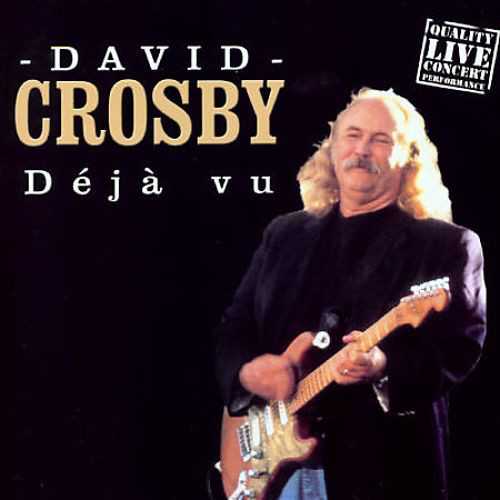 | Album: 7 of 13 Title: Déjà Vu Released: 2001 Tracks: 14 Duration: 1:12:34 Scroll: Up Down Top Bottom 25% 50% 75% AlbumCover | 1 Wooden Ships (08:01) 2 Compass (04:11) 3 Lady of the Harbor (03:39) 4 Oh Yes I Can (05:29) 5 Monkey and the Underdog (04:22) 6 Guinnevere (05:07) 7 Déjà Vu (07:46) 8 Delta (05:09) 9 Tracks in the Dust (05:01) 10 Almost Cut My Hair (05:17) 11 Nighttime for the Generals (04:07) 12 In My Dreams (04:38) 13 Drive My Car (03:51) 14 Long Time Gone (05:51) |
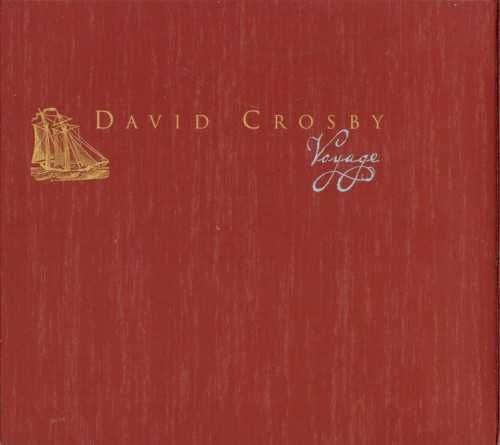 | Album: 8 of 13 Title: Voyage Released: 2006-11-06 Tracks: 52 Duration: 3:47:02 Scroll: Up Down Top Bottom 25% 50% 75% Wikipedia AlbumCover | 1 Eight Miles High (03:36) 2 Renaissance Fair (01:54) 3 Everybody’s Been Burned (03:01) 4 Wooden Ships (05:27) 5 Guinnevere (04:39) 6 Long Time Gone (04:17) 7 Déjà Vu (04:10) 8 Almost Cut My Hair (04:21) 9 Tamalpais High (at About 3) (03:32) 10 Laughing (05:25) 11 Music Is Love (03:21) 12 Song With No Words (Tree With No Leaves) (06:00) 13 What Are Their Names (04:14) 14 I’d Swear There Was Somebody Here (01:19) 15 Where Will I Be? (03:20) 16 Page 43 (02:55) 17 Critical Mass (01:20) 18 Carry Me (03:34) 19 Bittersweet (02:38) 20 Naked in the Rain (02:26) 21 Dancer (04:50) 1 Shadow Captain (04:31) 2 In My Dreams (05:13) 3 Delta (04:15) 4 Compass (05:27) 5 Tracks in the Dust (04:48) 6 Arrows (03:51) 7 Hero (04:38) 8 Yvette in English (05:53) 9 Rusty and Blue (07:30) 10 Somehow She Knew (07:05) 11 Breathless (05:16) 12 Map to Buried Treasure (05:33) 13 At the Edge (04:21) 14 Through Here Quite Often (04:00) 15 My Country Tis of Thee (01:53) 1 Long Time Gone (demo) (04:32) 2 Guinnevere (alternate mix) (04:19) 3 Almost Cut My Hair (demo) (05:22) 4 Games (demo) (03:05) 5 Deja Vu (demo) (02:36) 6 Triad (demo) (05:26) 7 Cowboy Movie (studio version) (10:57) 8 Kids and Dogs (06:58) 9 Have You Seen the Stars Tonite (alternate mix) (03:06) 10 The Lee Shore (live) (04:24) 11 Traction in the Rain (live) (03:36) 12 King of the Mountain (demo) (02:44) 13 Homeward Through the Haze (alternate mix) (04:22) 14 Samurai (studio version) (01:40) 15 Climber (studio version) (05:18) 16 Dream for Him (live) (07:57) |
 | Album: 9 of 13 Title: Live At The Matrix December 1970 Released: 2014 Tracks: 8 Duration: 1:03:19 Scroll: Up Down Top Bottom 25% 50% 75% Allmusic AlbumCover | 1 Drop Down Mama (04:20) 2 Cowboy Movie (09:50) 3 Triad (09:48) 4 The Wall Song (07:56) 5 Bertha (04:16) 6 Deep Elem Blues (07:15) 7 Motherless Children (09:14) 8 Laughing (10:40) |
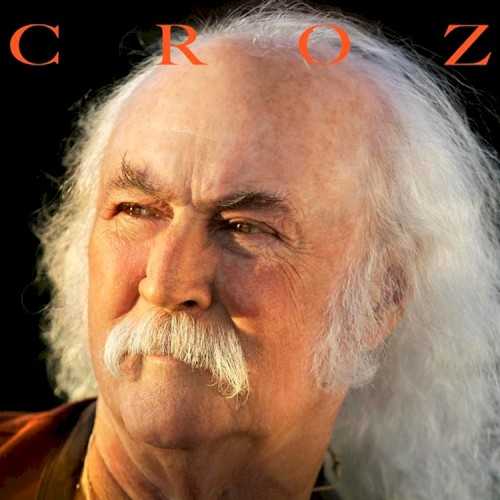 | Album: 10 of 13 Title: Croz Released: 2014-01-28 Tracks: 13 Duration: 54:49 Scroll: Up Down Top Bottom 25% 50% 75% Spotify Wikipedia Allmusic AlbumCover | 1 What’s Broken (03:48) 2 Time I Have (03:49) 3 Holding On to Nothing (03:41) 4 The Clearing (04:00) 5 Radio (03:45) 6 Slice of Time (04:16) 7 Set That Baggage Down (04:01) 8 If She Called (04:59) 1 Dangerous Night (05:57) 2 Morning Falling (03:41) 3 Find a Heart (05:04) 4 What’s Broken (03:48) 5 The Clearing (04:00) |
| Croz : Allmusic album Review : Its been 20 years since David Crosby released a collection of new songs, but hes hardly been quiet in those two decades. His occasional reunions with Stephen Stills, Graham Nash, and sometimes Neil Young get the most attention, but he also appeared on David Gilmours 2006 album On an Island and, more notably, often worked with his son James Raymond on a band called CPR. Raymond is Davids chief collaborator on Croz, a skillful evocation of Crosbys early-70s haze as filtered through early-90s professionalism. As always, Crosby is supported by a cast of heavy-hitters, but where 1993s A Thousand Roads sometimes seemed weighed down by cameos (an emphasis on covers also helped shift the spotlight away from the man at the center), Croz is tastefully decorated with sly solos by Mark Knopfler and Wynton Marsalis, the focus forever remaining on Croz himself. At the age of 72, his voice remains sweet, sometimes airy, and he and Raymond take advantage of both qualities, occasionally conjuring ghosts of CSNs early-80s soft rock ("Radio" could easily have slipped onto Daylight Again), but usually allowing the music to amiably drift and linger, sometimes settling in the conscious, sometimes dissipating. Even with songs as spare and haunting as "If She Called" -- nothing more than an electric guitar and voice there -- Croz is too dedicated to tasty, in-the-pocket grooves and cleanly sculpted digital production to truly be an heir to If I Could Only Remember My Name, but its the only other solo record of Crosbys that attempts to reckon with similar emotions and sounds. That Croz prefers certainty to the untrammeled melancholy of If I Could Only Remember My Name is a reflection of where he stands in 2014: hes aware hes building upon a past he sometimes pines for, yet hes restless enough to forage ahead into new territory, but only when hes surrounded by cozy, familiar settings. | ||
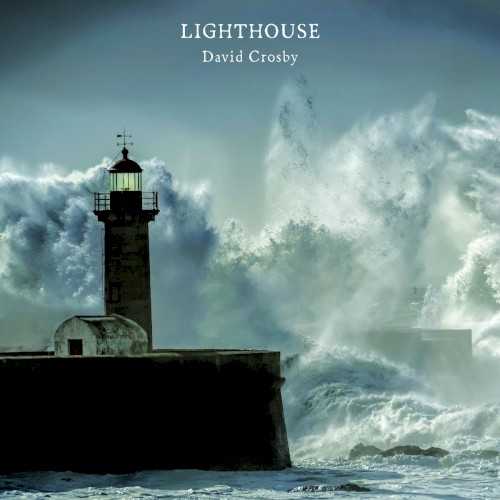 | Album: 11 of 13 Title: Lighthouse Released: 2016-10-21 Tracks: 9 Duration: 40:43 Scroll: Up Down Top Bottom 25% 50% 75% Spotify Allmusic AlbumCover | 1 Things We Do for Love (04:15) 2 The Us Below (03:42) 3 Drive Out to the Desert (04:16) 4 Look in Their Eyes (04:39) 5 Somebody Other Than You (04:24) 6 The City (04:45) 7 Paint You a Picture (04:25) 8 What Makes It So? (04:00) 9 By the Light of Common Day (06:14) |
| Lighthouse : Allmusic album Review : With the appearance of Lighthouse, singer/songwriter David Crosby, age 75, continues a late-career renaissance that began with 2014s Croz -- his proper studio follow-up to 1971s classic If I Could Only Remember My Name. This set was produced by Snarky Puppy boss Michael League, who co-wrote five of these nine tunes with Crosby. The producer, a lifelong fan of the 1971 album, approached Crosby about recording something quick and dirty over a couple of weeks. He was met with incredulousness. The artist was used to working on albums for months, even years. After three days, they completed three new songs, and Crosby was all in. Loosely modeled on the 1971 album, this is a more stripped-down affair, immediate, even raw in places. Crosbys acoustic guitar, vocals, and layered harmonies are accompanied by League playing assorted guitars and basses and managing studio atmospherics. Opening track and single "Things We Do for Love" is breezy and attractive with a trademark hook in the refrain, but it offers a subtle proof: That Crosbys golden voice is indeed subject to the march of time. The slight graininess in his delivery is used to wonderful effect on "The Us Below" as its arrangement bridges progressive folk and jazzy pop. Speaking of jazz, "Look in Their Eyes" contains a bluesy guitar and bass vamp that frames the singers elastic phrasing amid shifting time signatures, punctuated with a dreamy bridge. "What Makes It So" is slippery, folky rock. Its one of two tracks to feature organist Cory Henry on a haunting B-3, as Leagues slide playing enhances the most hummable melody here. Pianist Bill Laurance also appears twice, most notably on the closer "By the Light of a Common Day" by Crosby and Becca Stevens. She and Michelle Willis add backing vocals to an Anglo-Celtic folk melody extrapolated toward sophisticated adult pop. Leagues electric guitar rings in the background, underscoring the interplay between the singers. As a whole, Lighthouse doesnt reach the creative level of its 1971 inspiration. "Paint You a Picture," co-written by the singer with Marc Cohn, suffers from the formers generic melody. It hangs a poignant poetic lyric out to dry -- Laurances piano fills almost rescue it, but not quite. Throughout, theres a sameness in tempo and production values that results in a pleasant but blurry dream effect. Its too easy to get absorbed in the records sound and not pay attention to the songs, many of which are quite fine. Lighthouse is lovely, but the lack of attention to detail blunts some of the writing and playing craft on offer. | ||
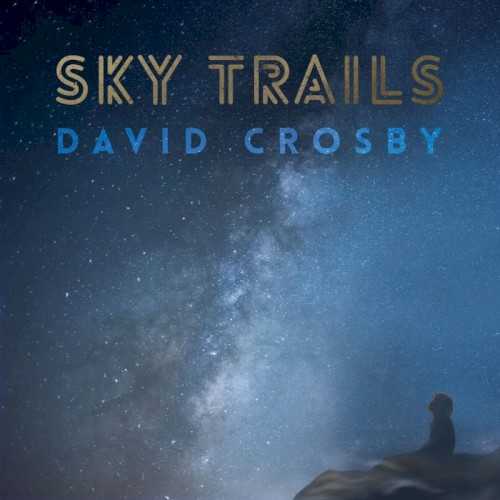 | Album: 12 of 13 Title: Sky Trails Released: 2017-09-29 Tracks: 12 Duration: 59:15 Scroll: Up Down Top Bottom 25% 50% 75% Spotify Allmusic AlbumCover | 1 She’s Got to Be Somewhere (04:47) 2 Sky Trails (04:51) 3 Sell Me a Diamond (05:28) 4 Before Tomorrow Falls on Love (03:52) 5 Here It’s Almost Sunset (03:53) 6 Capitol (06:57) 7 Amelia (05:38) 1 Somebody Home (04:38) 2 Curved Air (04:45) 3 Home Free (05:40) 4 She’s Got to Be Somewhere (04:47) 5 Here It’s Almost Sunset (03:53) |
| Sky Trails : Allmusic album Review : With an unexpected vigor, David Crosbys late-career renaissance continues as he delivers Sky Trails, his third solo effort in four years. Arriving hot on the heels of 2016s Michael League-produced Lighthouse, Sky Trails splits the difference between its predecessors spare acoustic ruminations and the singer/songwriters fascination with jazz. Produced by his multi-instrumentalist son, James Raymond, much of this set brandishes a full band as Crosby and his collaborators explore Steely Dan-style grooves on the funky opener, "Shes Got to Be Somewhere," or politicized jazz-folk on the harmony-stacked "Capitol." On the gentler, more introspective side, piano ballads like "Before Tomorrow Falls on Love" and the excellent "Home Free" distinctively recall the mid-70s experimental heyday of longtime friend and peer Joni Mitchell, whose gorgeous "Amelia" Crosby faithfully covers here. Tonally and instrumentally, quite a bit of Sky Trails shares a kinship with Mitchell masterpieces like Hejira and The Hissing of Summer Lawns, utilizing fretless bass, jazz piano, soprano sax, and unconventional chord structures. On the folkier side, another highlight is the lovely acoustic title cut, co-written and co-sung by North Carolina singer/songwriter Becca Stevens. As a whole, Crosby touches on a number of pleasing themes and sounds on Sky Trails, lending his sweet tenor and trademark harmonies to material of surprisingly high quality given his recent prolificacy. | ||
 | Album: 13 of 13 Title: Here If You Listen Released: 2018-10-26 Tracks: 11 Duration: 45:11 Scroll: Up Down Top Bottom 25% 50% 75% Spotify TrackSamples AlbumCover | 1 Glory (05:20) 2 Vagrants of Venice (04:06) 3 1974 (03:00) 4 Your Own Ride (04:34) 5 Buddha on a Hill (04:07) 6 I Am No Artist (04:37) 7 1967 (03:19) 8 Balanced on a Pin (04:30) 9 Other Half Rule (04:34) 10 Janet (03:27) 11 Woodstock (03:34) |